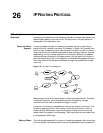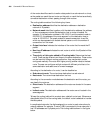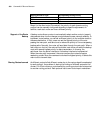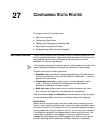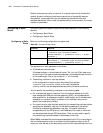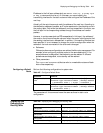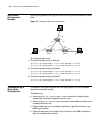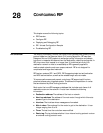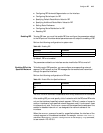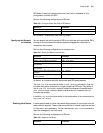
410 CHAPTER 27: CONFIGURING STATIC ROUTES
Default routes are very useful in network. In a typical network with hundreds of
routers, dynamic routing protocols may consume lots of bandwidth resource.
Using default route means that you can replace high bandwidth links with
adequate bandwidth links to meet the requirements of communication for a large
number of subscribers.
Configuring a Static
Route
Configuring static and default routes involves tasks described in the following
sections:
■ Configuring a Static Route
■ Configuring a Default Route
Configuring a Static
Route
Perform the following configurations in system view.
Table 466 Configure a Static Route
The explanation of each parameter is as follows:
■ IP address and network mask
IP address is shown in dotted decimal format. The 1s in the 32 bit mask must
be continuous. The mask can also be presented in the dotted decimal format or
by the mask length, that is, the number of “1”s in the mask.
■ Transmitting interface or next hop address
In the configuration of static routes, the transmitting interface
interface-type interface-number or the next hop address
nexthop-address can be designated as required by the actual conditions.
You can specify the transmitting interfaces in the following cases:
■ For interfaces that support resolution from the network address to the link
layer address (like Ethernet interface supporting ARP), if a host address has
been specified for Ip-address and mask (or mask-length), and if the destination
address is in a network directly connected to this interface, then you can
specify the transmitting interface.
■ For a point-to-point type interface, specifying the transmitting interface implies
specifying the address of next hop. In this case the address of the remote
interface is considered the address of next hop. If the serial interface is
encapsulated with the PPP protocol, the IP address of the node on other end
can be determined through PPP consultation. Then you only need to specify
the transmitting interface instead of the address of next hop.
When NBMA interfaces like the interface encapsulated with X.25 or frame relay or
dial-up interface support point-to-multipoint mode, besides configuring the IP
route, you must also set up the secondary route at the link layer and map from the
Operation Command
Configure a static route ip route-static ip-address { mask | mask-length }
{ interface-type interface-number |
nexthop-address } [ preference value ] [ reject |
blackhole ]
Delete a static route undo ip route-static { all | ip-address { mask |
mask-length } [ interface-type interface-number |
nexthop-address ] [ preference value ] }






